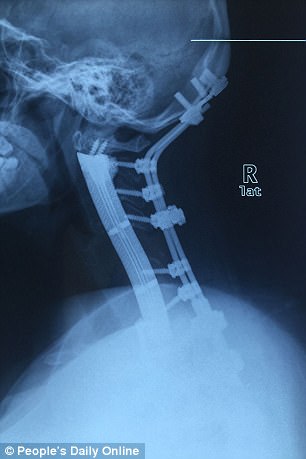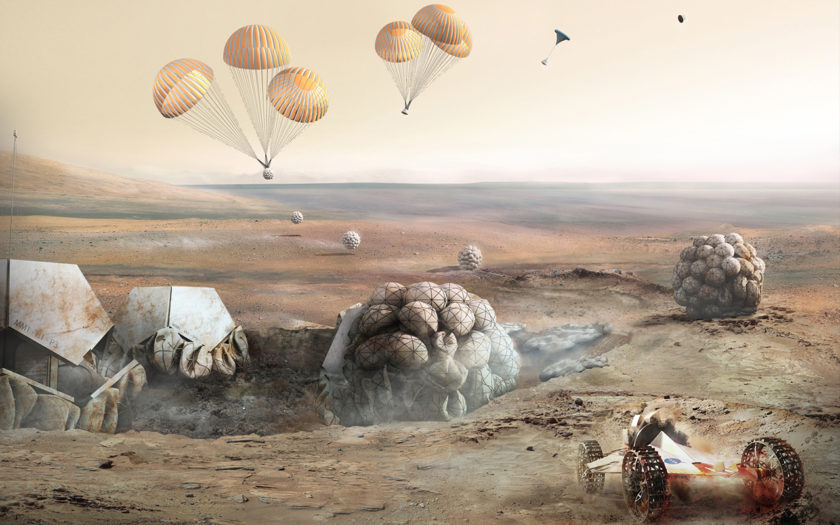We knew that 3D printing was changing our day-to-day lives on Earth. What’s becoming more and more obvious is that it’s also changing our chances for survival, here and beyond. This week in 3D printing, we saw a man get a new skull, a woman saved with a new spine, blood vessel proof-of-concept prints, and a couple of huge breakthroughs in the print-in-space race. So buckle up, because where we’re going, we don’t need roads (or… injection molding).
This is getting mental
USA Today brought us the story of Dr. Gaurav Gupta, who recently became the first to implant a 3D printed partial skull. Partnering with medical device company DeputSynthese CMS, Dr. Gupta developed a custom cranial implant made of a polyetheretherketone (PEEK), a plastic that isn’t rejected by the body, is impact- and fracture-resistant, and won’t dissolve — so most of the dangers of implants are averted. Don’t go around without a helmet just yet, though. This is a promising, but emerging use of 3D printing. Still, it might just save your head one day.
Backbone is not underrated
A tumor that wraps itself around the spine, endangering nerves, movement, and overall survival was once a nearly insurmountable challenge. Thanks to 3D printing, we now have solutions — like the six consecutive cervical vertebrae printed in China for a patient with chondrosarcoma, a rare form of cancer. The part of the spine that supports the neck, the cervical vertebrae are the most delicate bones in the body, so this first-of-its-kind titanium alloy 3D print is promising for a variety of other applications. Yet another reason to keep your chin up.

The new cervical vertabrae in situ. (via People’s Daily Online)
Human-free human drug trials
We talk a lot about printing organs, a breakthrough that could save an untold number of lives. But, there are steps we have to take before that can become a reality. One of the key steps is printing any kind of vascularized tissue — tissue that contains functional blood vessels. As Singularity Hub reported, a multinational team of researchers has taken a concrete step toward doing just that. Key to the breakthrough is a process for creating endothelial layers, or blood vessel walls. The team first printed liver tissue with 3D printed blood vessels. Then the vessels, printed in “sacrificial” ink, were dissolved. Finally, they added the endothelial stem cells to the tissue to create true blood vessels with selectively permeable, but still stable walls. All of this allows us to approximate how drugs, toxins, and other substances enter the liver. Hopefully, this will lead to a day when drug labels include “No animals were harmed during the making of this medication.”

Someone is happy we’re figuring out this whole “printing organs so we don’t have to experiment on animals anymore” thing. (“Chimpanzee” image by Flickr user Steve Snodgrass, CC BY 2.0)
Printers that are ready for their spacewalk
Made In Space, the company with two 3D printers already running on the International Space Station, calls its Archinaut project a “technology platform that enables autonomous manufacture and assembly of spacecraft systems on orbit.” That translates to 3D printers that can operate outside the walls of the ISS, assembling parts in the vacuum of space. The first proof-of-concept for Archinaut, technically called the Extended Structure Additive Manufacturing Machine (ESAMM), came recently when the ESAMM was able to print an almost meter-long part in a thermal vacuum chamber. As Engineering.com reported, this is the first step toward the goal of printing and assembling large-scale objects like satellites and space station modules without having to return to Earth. Let’s hope there’s always an Earth to 3D print things on, but in case that doesn’t work out, it’s good to have a backup.
Those in plastic houses… should really think about incorporating concrete
In the quest to figure out how to build off-planet housing, NASA’s 3D Printed Habitat Challenge has been fostering the creativity of citizen inventors. The Habitat Challenge includes different stages of competition based on key constructed elements. The rules dictate that a combination of plastic and simulated Martian soil should be used to create these structural elements. As Plasticsnews.com reported, the latest competition involved 3D printing a structural beam, and a team comprised of Branch Technology, architecture firm Foster + Partners, and material developer Techmer took the top prize (they also won the previous level). What’s more, “Recyclable plastics were used in the top three scoring teams, indicating that a thermoplastic concrete material may be viable for 3D printing habitats on Mars,” as NASA’s Rob Meuller explained. Looks like we might just make it to the next environment we’ll live in without doing anything toooooo terrible to our own.

Could this be where we’ll retire? (NASA Challenge Image via Foster + Partners)



That’s really cool that they are looking into using 3D printers in space. I think it’s neat how versatile 3D printers are. They can create complex things like robots, or even just print you a plastic ring.